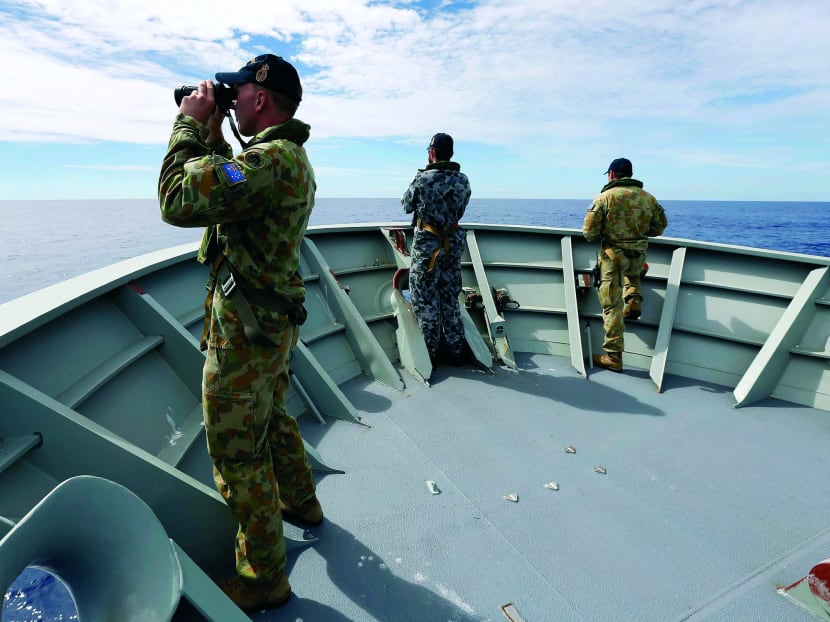Possible fifth ping detected in search for missing plane
PERTH — An Australian aircraft yesterday detected what may be the fifth signal coming from a man-made device deep in the Indian Ocean, adding to hopes searchers will soon pinpoint the object’s location and send a robotic vehicle to confirm if it is a black box from the missing Malaysian jet.

Australian sailors on HMAS Perth looking for debris from the missing Malaysia Airlines Flight MH370. Photo: Reuters
PERTH — An Australian aircraft yesterday detected what may be the fifth signal coming from a man-made device deep in the Indian Ocean, adding to hopes searchers will soon pinpoint the object’s location and send a robotic vehicle to confirm if it is a black box from the missing Malaysian jet.
The Australian Air Force P-3 Orion, which has been dropping sonar buoys into the water near where four earlier sounds were heard, picked up a “possible signal” that may be from a man-made source, said Mr Angus Houston, who is coordinating the search off Australia’s west coast. “The acoustic data will require further analysis overnight,” he said in a statement.
If confirmed, the signal would further narrow the hunt for Malaysia Airlines Flight MH370, which vanished on March 8 while flying from Kuala Lumpur to Beijing with 239 people on board.
The Australian ship Ocean Shield picked up two underwater sounds on Tuesday. Two sounds it detected on Saturday were determined to be consistent with the pings emitted from a plane’s flight recorders, or black boxes.
The Australian Air Force has been dropping sonar buoys to better pinpoint the location of the sounds detected by Ocean Shield in a search zone that is now the size of Los Angeles.
Royal Australian Navy Commodore Peter Leavy said each buoy is dangling a hydrophone listening device about 300m below the surface. Each buoy transmits its data via radio back to the plane.
The underwater search zone is currently a 1,300-sq-km patch of the ocean floor and narrowing the area as much as possible is crucial before an unmanned submarine can be sent to create a sonar map of a potential debris field on the seabed.
An autonomous underwater vehicle named Bluefin-21 is on board the Ocean Shield and could be deployed to look for wreckage on the sea floor once the final search area has been positively identified.
The search for floating debris on the ocean surface was narrowed yesterday to its smallest size yet — 57,900 sq km, or about one-quarter the size it was a few days ago. Fourteen planes and 13 ships were looking for floating debris about 2,300km north-west of Perth.
The locator beacons on the black boxes holding the flight data and cockpit voice recorders have a battery life of about a month, and Tuesday marked one month since Flight MH370 disappeared. The plane veered thousands of kilometres off-course for an unknown reason, so the data on the black boxes are essential to finding the plane and solving the mystery.
Investigators suspect it went down in the southern Indian Ocean based on a flight path calculated from its contacts with a communications satellite, as well as analysis of its speed and when it would have run out of fuel.
An Australian government briefing document circulated among international agencies involved in the search yesterday said it was likely that the acoustic pingers would continue to transmit at decreasing strength for up to 10 more days, depending on conditions.
Once there is no hope left of the Ocean Shield’s equipment picking up any more sounds, the Bluefin sub will be deployed.
Complicating matters, however, is the depth of the sea floor in the search area. The pings detected earlier are emanating from 4,500m below the surface — which is the deepest the Bluefin can dive.
“It’ll be pretty close to its operating limit. It’s got a safety margin of error and if they think it’s warranted, then they will push it a little bit,” said Dr Stefan Williams, a professor of marine robotics at Sydney University. AGENCIES






